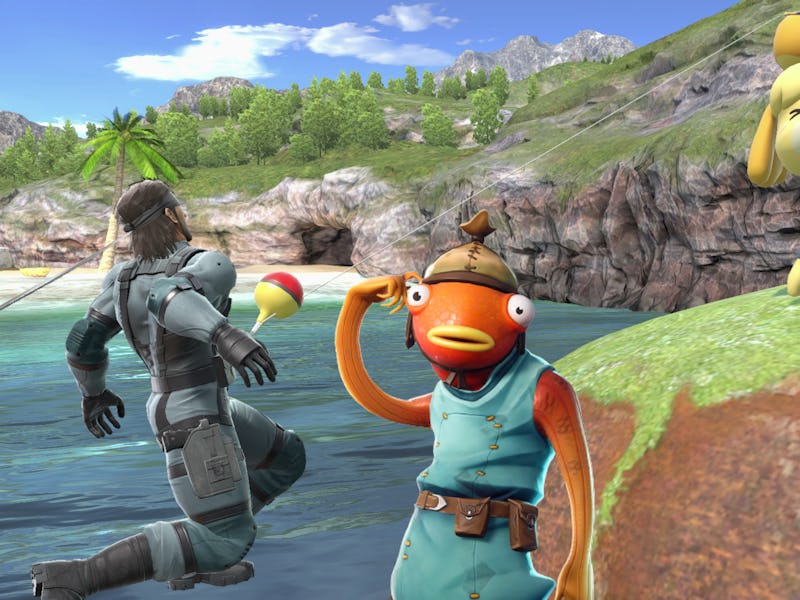Fortnite crossovers are missing the 1 thing that makes Smash Bros. work
Fortnite's ongoing pop culture parade is a hollow spectacle.

Baby Yoda. Master Chief. GI Joe. Fortnite is becoming a who’s who of pop culture titans. The popular battle royale game is currently in the midst of a yet another star-studded season, bringing bounty hunters from around the multiverse together to compete for a Victory Royale. And this came right after an entire season devoted to heroes and villains from Marvel Comics.
The multiplayer phenomenon has long flirted with crossover events, but it’s now entered full Super Smash Bros. territory with a huge roster full of playable icons. Granted, Fortnite characters are almost entirely just cosmetic skins, but there’s one thing that fundamentally separates Nintendo’s fighting game franchise from Epic’s mega-hit: Super Smash Bros. has heart.
The Super Smash Strategy
The Super Smash Bros. series is a love letter to video games. That shows in Nintendo’s approach to character design. Every single new fighter brings their personal history into the game. Play a character like Mr. Game & Watch, and you can spend a play session reflecting on how each of his moves riffs on something from one of his classic handheld games. Each time a new character drops, it's thrilling to take them into a match for the first time to see all the ways Nintendo captured their storied past.
It’s not just the characters themselves either. Super Smash Bros. Ultimate is filled with items, stages, and music from gaming history, which makes it feel less like a game and more like a playable museum. Each new character drop opens another wing in the best video game hall of fame around.
Other games have done an excellent job at following Nintendo’s lead. Dead By Daylight most notably takes a similar approach into the world of horror, making each new DLC feel like a full-on homage to the genre. Seeing Silent Hill’s Pyramid Head and Freddy Kreuger in the same game is one thing. Seeing them both operate with entirely different mechanics that represent their worlds while still fitting into Dead By Daylight’s structure is morbidly magical.
An Epic (Games) Marketing Stunt
Fortnite’s pop culture strategy is less compelling. For the most part, new characters strictly bring cosmetics into the game. If a player drops a wad of V-Bucks to unlock Master Chief, they’re just getting a new skin that operates the same way as Fortnite’s default characters. Players can’t throw a sticky grenade or fire a needler; They’ll just do their standard Fortnite actions in a new costume. The aesthetic is there minus the personality. And in almost every case, each new skin comes with zero personality.
Epic does put in some extra effort when it comes to accessories, though they’re largely a paint job with no unique function. Players can buy Master Chief’s Gravity Hammer to replace their pickaxe, but it’s purely for show. That makes items feel less like carefully crafted love letters to other franchises and more like the cheap plastic extras that come packaged with an action figure.
The main distinction between Super Smash Bros. and Fortnite is that the former is about celebration, while the latter is about expression. Epic isn’t trying to create a playable historical document. It’s focused on Fortnite first, above all else. New characters and items just give fans more ways to customize their characters to keep rounds visually appealing. Kratos and The Terminator are merely special guest stars with cameos in an ongoing sitcom that’s very careful not to break its established format.
It’d be a stretch to call the strategy soulless. There’s plenty of value to Epic’s approach as it further transforms the game into its own contained meta-verse. Wearing a Batman skin in-game isn’t so different than wearing a Batman t-shirt in real life. Plus, some of the game’s more involved events, like last season’s Marvel-themed Nexus War, do go above and beyond to refresh the sandbox in creative ways.
The Mandalorian and Baby Yoda in Fortnite.
Even still, it’s easy to feel disillusioned as the game’s shop continues to fill up with random characters. This current bounty hunter-themed season started off with a bit of excitement thanks to The Mandalorian and Baby Yoda, but each subsequent character reveal has felt increasingly more excessive. Something like a G.I. Joe crossover now feels obvious instead of novel. Without the element of surprise, the marketing stunt feels more exhausting and cynical.
It’s not like Nintendo is making new Smash characters purely out of the goodness of its heart, either. Like Epic Games does with Fortnite, Nintendo is using a monetization strategy to pull some extra cash from players. The endgame is the same, but the sales pitch is different. Each Super Smash Bros. Ultimate character pack expands the game by adding new strategic options that deepen the experience for both casual and competitive players. Fortnite’s cosmetics, by comparison, are mostly good for a quick laugh.
By all accounts, that seems to be enough for many players out there. A video game experience doesn’t have to be that deep. Buying a Kratos skin just to make it dab is absurd and entertaining in a way that feels in line with an ever-expanding meme universe. It’s just that Fortnite has a rare opportunity to honor many disparate media worlds in one game to create something that transcends gimmick.
Instead, it’s a late-night talk show that’s more interested in asking a few softball questions, throwing to a clip, and moving on to the next guest in a flashy by forgettable — and predictable — manner.
This article was originally published on